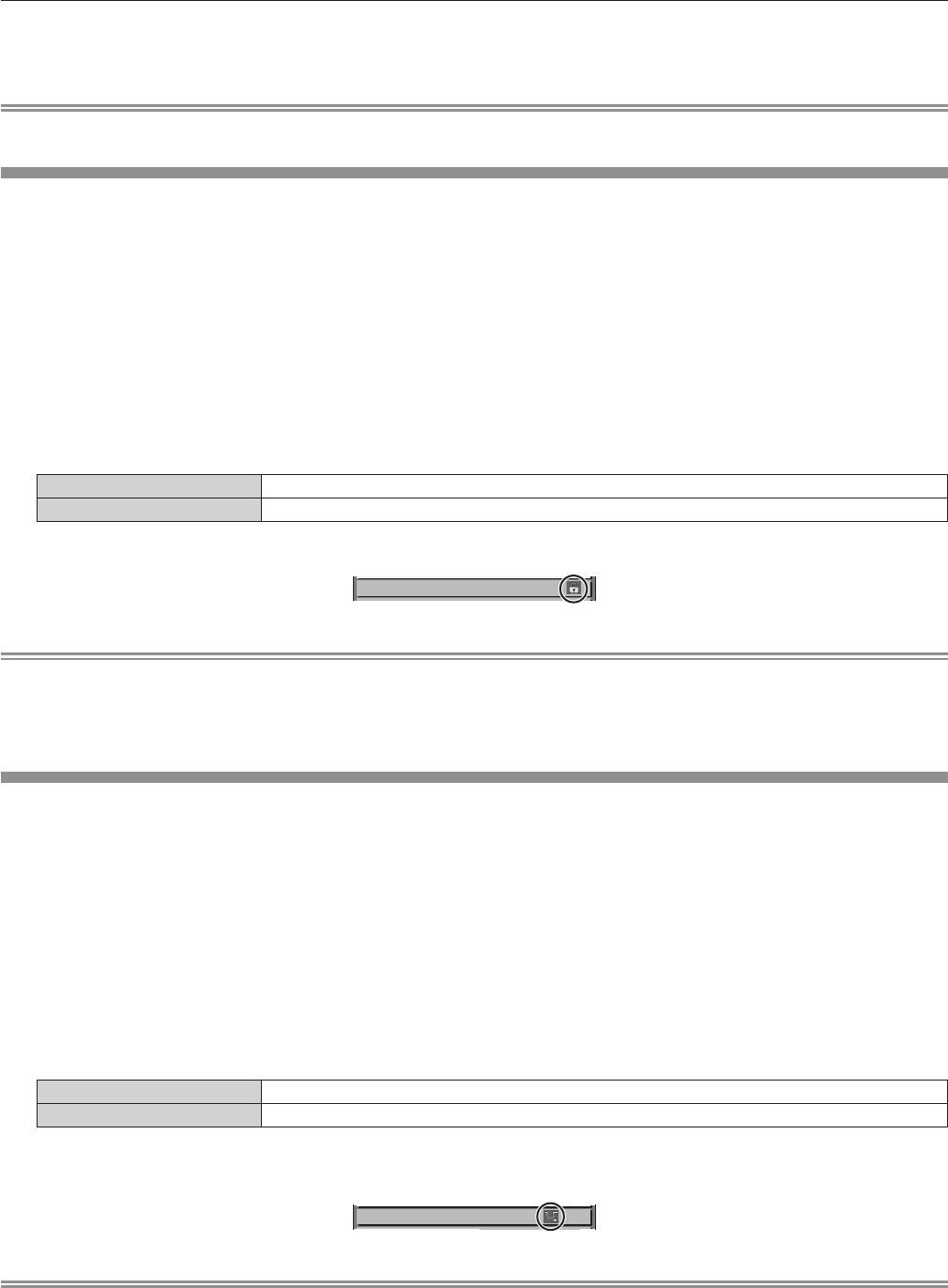Operation Manual
Table Of Contents
- Read this first!
- Chapter 1 Preparation
- Chapter 2 Getting Started
- Chapter 3 Basic Operations
- Switching on/off the projector
- Projecting
- Operating with the remote control
- Switching the input
- Using the shutter function
- Using the on-screen display function
- Using the automatic setup function
- Switching the image aspect ratio
- Using the function button
- Displaying internal test pattern
- Using the status function
- Using the AC voltage monitor function
- Setting ID number of the remote control
- Chapter 4 Settings
- Menu navigation
- [PICTURE] menu
- [POSITION] menu
- [ADVANCED MENU] menu
- [DISPLAY LANGUAGE] menu
- [3D SETTINGS] menu
- [DISPLAY OPTION] menu
- [COLOR MATCHING]
- [LARGE SCREEN CORRECTION]
- [SCREEN SETTING]
- [AUTO SIGNAL]
- [AUTO SETUP]
- [BACKUP INPUT SETTING]
- [SIMUL INPUT SETTING]
- [RGB IN]
- [DVI-D IN]
- [HDMI IN]
- [DIGITAL LINK IN]
- [SDI IN]
- [ON-SCREEN DISPLAY]
- [IMAGE ROTATION]
- [BACK COLOR]
- [STARTUP LOGO]
- [UNIFORMITY]
- [SHUTTER SETTING]
- [FREEZE]
- [WAVEFORM MONITOR]
- [CUT OFF]
- [PROJECTOR SETUP] menu
- [PROJECTOR ID]
- [PROJECTION METHOD]
- [OPERATION SETTING]
- [LIGHT OUTPUT]
- [BRIGHTNESS CONTROL]
- [STANDBY MODE]
- [NO SIGNAL SHUT-OFF]
- [NO SIGNAL LIGHTS-OUT]
- [INITIAL STARTUP]
- [STARTUP INPUT SELECT]
- [DATE AND TIME]
- [SCHEDULE]
- [RS-232C]
- [REMOTE2 MODE]
- [FUNCTION BUTTON]
- [LENS CALIBRATION]
- [LENS MEMORY]
- [STATUS]
- [AC VOLTAGE MONITOR]
- [SAVE ALL USER DATA]
- [LOAD ALL USER DATA]
- [INITIALIZE]
- [SERVICE PASSWORD]
- [P IN P] menu
- [TEST PATTERN] menu
- [SIGNAL LIST] menu
- [SECURITY] menu
- [NETWORK] menu
- Chapter 5 Maintenance
- Chapter 6 Appendix

Chapter 4 Settings — [SIGNAL LIST] menu
150 - ENGLISH
3) Press the <ENTER> button.
f The selected signal will be deleted.
Note
f A registered signal can also be deleted from [REGISTERED SIGNAL DELETE] on the [REGISTERED SIGNAL SETUP] screen.
Protecting the registered signal
1) Press asqw to select the signal to protect.
2) Press the <ENTER> button.
f The [REGISTERED SIGNAL STATUS] screen is displayed.
3) Press the <ENTER> button.
f The [REGISTERED SIGNAL SETUP] screen is displayed.
4) Press as to select [LOCK].
5) Press qw to switch the item.
f The items will switch each time you press the button.
[OFF] The signal is not protected.
[ON] The signal is protected.
f A lock icon is displayed at the right of the [SIGNAL LIST] screen when [LOCK] is set to [ON].
RGB2
RGB2
RGB2
A3: XGA75-A3
A1: 720/60p-A1
A2: 1280x1024/60-A2
Note
f When [LOCK] is set to [ON], signal deletion, image adjustment, and automatic setup are not available. To perform these operations, set
[LOCK] to [OFF].
f A signal can be registered to the sub memory even if it is protected.
f Even a protected signal will be deleted if [INITIALIZE] is executed.
Expanding signal lock-in range
1) Press asqw to select the signal to set.
2) Press the <ENTER> button.
f The [REGISTERED SIGNAL STATUS] screen is displayed.
3) Press the <ENTER> button.
f The [REGISTERED SIGNAL SETUP] screen is displayed.
4) Press as to select [LOCK-IN RANGE].
5) Press qw to switch the item.
f The items will switch each time you press the button.
[NARROW] Select in most cases.
[WIDE] Widens the lock-in range.
f An expansion icon is displayed at the right of the [SIGNAL LIST] screen when [LOCK-IN RANGE] is set to
[WIDE].
RGB2
RGB2
RGB2
A3: XGA75-A3
A1: 720/60p-A1
A2: 1280x1024/60-A2
Note
f Switch the range where the signal to be input is determined to be the same signal as the already registered signal.
f To prioritize the determination that a signal is the same as the already registered signal, set this function to [WIDE].
f Use in cases such as when the synchronizing frequency of a signal to be input has changed slightly, or multiple signal lists are registered.
f This function can be used only when a signal is input from the <RGB 1 IN> terminal, the <RGB 2 IN> terminal, <DVI-D IN> terminal, the
<HDMI IN> terminal, or the <DIGITAL LINK/LAN> terminal.
f When [WIDE] is set, the image may be distorted because a signal is recognized as the same even if its synchronizing frequency varies
slightly.










